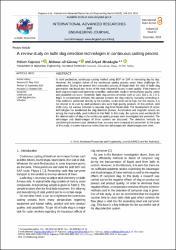| dc.contributor.author | Kapusuz, Hakan | |
| dc.contributor.author | Güvenç, Mehmet Ali | |
| dc.contributor.author | Mıstıkoğlu, Selçuk | |
| dc.date.accessioned | 2021-01-04T10:33:51Z | |
| dc.date.available | 2021-01-04T10:33:51Z | |
| dc.date.issued | 2019 | en_US |
| dc.identifier.citation | Kapusuz, H., Güvenç, M., Mıstıkoğlu, S. (2019). A review study on ladle slag detection technologies in continuous casting process . International Advanced Researches and Engineering Journal , 3(3) , 144-149.
https://doi.org/10.35860/iarej.421657 | en_US |
| dc.identifier.uri | https://doi.org/10.35860/iarej.421657 | |
| dc.identifier.uri | https://hdl.handle.net/20.500.12508/1609 | |
| dc.description.abstract | In steel production, continuous casting method using BOF or EAF is increasing day by day. However, the complex nature of the continuous casting process poses many challenges for steelmakers. During the general steel production process of liquid steel, the state of ladle slag penetration into liquid steel is one of the most influential factors in steel quality. If the ingress of ladle slag into liquid steel cannot be controlled, undesirable results in terms of poor quality, safety and castability can occur. Generally, ladle slag consists of oxides such as CaO, SiO 2, Al 2 O 3, MgO. In conventional methods, the operator prevents the slag entry by manually controlling it. This method is performed directly by the operator, so the error rate is high. For this reason, it is not desired to be used by steel producers who want high quality products. In this context, steel mills carry out various activities to separate slag from liquid steel. The development of sensor technologies has accelerated the slag detection process. Acceleration and magnetic sensors are among the most widely used methods in this field. In this study, the systems used worldwide for the determination of slag in the continuous casting process were investigated and presented. The advantages and disadvantages of these systems are discussed. The detection methods by considering investment cost, detection time, accuracy were compared and presented. In the scope of this study, it is seen that every method has own advantages and disadvantages over other. | en_US |
| dc.language.iso | eng | en_US |
| dc.publisher | International Advanced Researches and Engineering Journal | en_US |
| dc.relation.isversionof | 10.35860/iarej.421657 | en_US |
| dc.rights | info:eu-repo/semantics/openAccess | en_US |
| dc.subject | Continuous cast | en_US |
| dc.subject | Ladle slag detection | en_US |
| dc.subject | Vibration | en_US |
| dc.title | A review study on ladle slag detection technologies in continuous casting process | en_US |
| dc.type | article | en_US |
| dc.relation.journal | International Advanced Researches and Engineering Journal | en_US |
| dc.contributor.department | Mühendislik ve Doğa Bilimleri Fakültesi -- Makina Mühendisliği Bölümü | en_US |
| dc.contributor.authorID | 0000-0001-5938-5759 | en_US |
| dc.contributor.authorID | 0000-0002-4652-3048 | en_US |
| dc.contributor.authorID | 0000-0003-2985-8310 | en_US |
| dc.relation.publicationcategory | Makale - Ulusal Hakemli Dergi - Kurum Öğretim Elemanı | en_US |
| dc.contributor.isteauthor | Kapusuz, Hakan | |
| dc.contributor.isteauthor | Güvenç, Mehmet Ali | |
| dc.contributor.isteauthor | Mıstıkoğlu, Selçuk | |
| dc.relation.index | TR-Dizin | en_US |
















